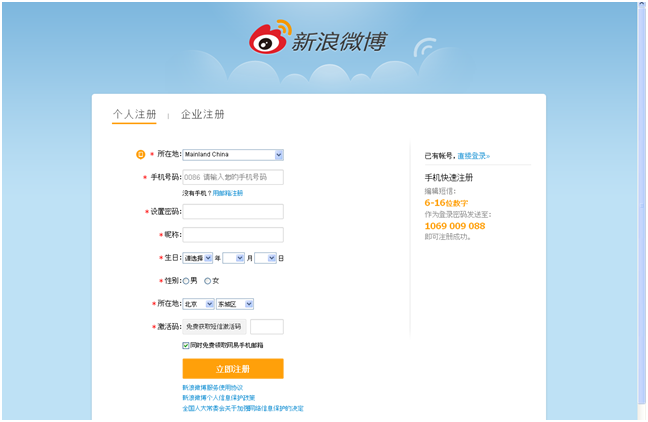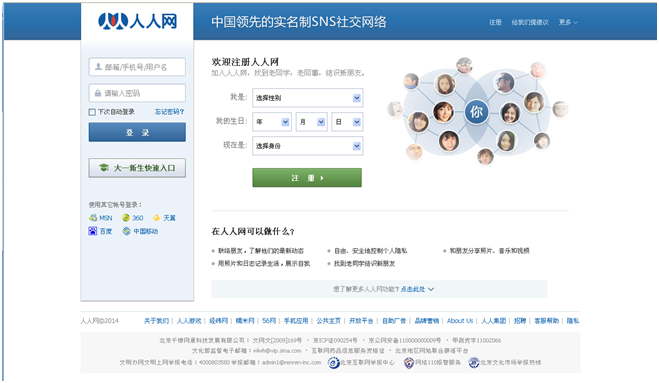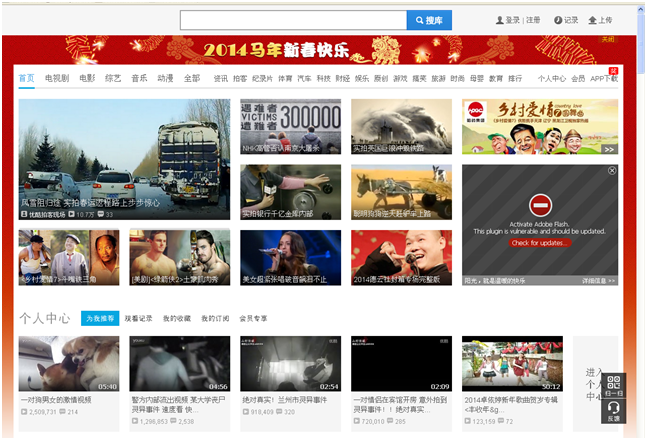Making up a whopping 1 in 4 people online, the Chinese internet market is the biggest in the world, with 600 million users. And excitingly, it’s still growing – making it a very attractive target for businesses. Social media is extremely popular in China, making it a great way to reach this huge audience.
Chinese government internet censorship is a big factor that marks out China as different. Accounts that post prohibited material risk being suspended or even permanently removed. Censorship in China goes beyond the content that would be blocked in most other countries, such as criticising the government or showing support for the independence of contested Chinese regions such as Tibet.
Similar to the rest of the world, the Chinese social media landscape has 3 key popular areas: social networks, micro-blogs and video websites. This landscape is radically different to anywhere else in the world however, so if you’re hoping to target the country you need to completely rethink your strategy. While in the rest of the world names like Facebook, Twitter and YouTube tend to dominate the social space, in China these sites are blocked and local alternatives such as Renren, Weibo and Youku attract users in their millions instead.
Using popular local networks such as these is key to success if you want to make an impact in China, so what exactly are the top sites you should be on, and how are they used? Here is a rundown of the main areas of social media that you need to consider in China.
Most popular Chinese social media sites
- Sina Weibo
- Tencent Weibo
- Qzone
- Renren
- Youku Tudou
- iQiyi
- PPS
Micro-blogs
Micro-blogging, where users post short messages which can be read by anyone who follows them, is extremely popular in China, with 85% of Chinese netizens having an account on a micro-blogging site. In many countries, the dominant micro-blogging site is Twitter, but in China the big names are Sina Weibo and Tencent Weibo.
There are some obvious similarities between these local networks and Twitter, such as the use of the @ and # symbols and the 140 character limit. It is worth noting, however, that 140 Chinese characters can convey a lot more information than 140 Latin characters. Chinese celebrities use micro-blogging sites to communicate with their fans and boost their brand, which indicates that businesses should also be able to boost their brand power if they can create engaging content that Chinese customers want to read and share. A final similarity between Twitter and local Chinese micro-blogging sites is that businesses can use promoted posts for advertising purposes.
There are key differences between these local Chinese micro-blogs and Twitter, however – mainly that the Chinese versions are more advanced than their Western counterparts. Users of Sina Weibo and Tencent Weibo have had the ability to share videos and images for a relatively long time, whereas Twitter has only just released this feature.
Weibo Page Management

Weibo is one of the most popular social media sites in China with users twice as active as those on Twitter. If you want to grow your brand in the Chinese market, you'll need to interact with your audience with fresh, relevant and high-quality content, including images and articles, that appeal to them. This will enable you to establish and maintain a vibrant social presence. We will manage your Weibo page, by adding new posts, monitoring activity and engaging with users. You will receive monthly reports detailing all of the activity generated by the posts, including likes, shares and comments. This service covers the management of one Weibo page.
Sponsored
Social networks
Social networks differ from micro-blogs in that users tend to share richer information with a smaller, more intimate group of people. Social networking sites typically allow users to build a network of friends, write posts, and share photos, videos and music. The biggest social network in the world is Facebook, which has over a staggering 1 billion users. Facebook is banned in China, however, and local giants Qzone and Renren dominate the Chinese social network space.
Renren is very much like Facebook, both visually with its blue interface and timeline layout, and in its features such as the ability to share statuses and photos, chat with friends and like pages. The site’s 172 million users are mainly students and graduates, although it is now trying to expand its appeal to a wider audience. Qzone, which is owned by the social giant Tencent, was one of the first ever social networks in China and, unlike Renren, attracts people from all demographics. Its 712 million registered accounts makes it the most popular media platform in China, meaning it is definitely a network to consider if you want to boost your brand awareness to a large number of people.
However, attention is beginning to shift away from these Chinese social networks. They are considered to belong to the past generation of social media sites, with micro-blogging sites such as Sina Weibo getting more hype and interest instead.
Renren Page Management

Renren is a popular social network widely known as the 'Chinese Facebook' and a channel where you need to be present if you want to engage with your Chinese audience on social media. Our Renren page management service includes daily posting by our in-house team of Chinese specialists and the management of communication with your fans.
Sponsored
Video websites
Video sharing websites allow users to upload videos to the platform, where they can then be watched by anyone. Users can typically comment on videos, put them into playlists and ‘like’ or ‘dislike’ them. Here, we are most familiar with the Google-owned video giant YouTube, but the site is banned in China and local sites Youku Tudou, iQiyi and PPS have flourished in its place.
Youku Tudou (often referred to as just Youku) is China’s most popular video sharing website. Formed in 2012 with the merger of Youku and Tudou, the website has 400 million monthly users. Youku permits users to upload videos and is partnered with over 1,500 license holders, including television stations, distributors, and film and TV production companies that regularly upload content to the site. Youku Tudou’s popularity makes it an excellent channel for reaching a Chinese audience and sharing your message.
IQiyi and PPS video sharing platforms were both recently bought by Baidu, the leading search engine in China. Although their currently popularity is low compared to the mighty Youku Tudou, with the hefty weight of Baidu of behind them, these video-sharing underdogs are sure to appear in the search engine’s results pages (SERPs) and have a tantalisingly promising future.
Ready to make a social impact in China?
So, now you know which social media sites you should be using to target a Chinese audience, how exactly do you get started? First of all, you need to team up with a native Chinese speaker. This is because not only are most websites’ interfaces in Chinese only, but in order to create content that your audience will understand and want to engage with, it must be written in Chinese. For best results, you need someone who speaks Chinese to monitor your social media accounts too, to see if there are any comments or replies that need a response.
Next, you need to register accounts on your desired social media sites. All the sites mentioned in this article allow Chinese and non-Chinese businesses to create pages, just remember that your content must comply with China’s censorship laws – so if you’re in the gambling or pornography industries for example, it probably isn’t worth it.
Assuming you’re able to create your accounts with no problems, you’re all set to create great content and crack the Chinese market. The social management tool Hootsuite now allows users to manage their Renren and Sina Weibo accounts through their dashboard, which should make things even easier. So, what are you waiting for? The opportunities for your business in China are big, and you’re now armed with the social media knowledge necessary to start a great Chinese social campaign – go for it!
Elin Box
Latest posts by Elin Box (see all)
- 4 local e-commerce websites that are beating Amazon in 2024 - July 25, 2024
- Digital marketing in North America in 2024 - July 18, 2024
- Top 8 countries for time spent online in 2024 - July 11, 2024









Hi Elin,
Thanks so much for your reply!!
I’m now trying to register with Big Fish but unfortunately they don’t seem to allow foreign mobile phone numbers for their verification… seems like a dead end. Bummer.
Thank you anyway!
Hi Tobias,
Ah OK, that’s a shame. Unfortunately we can’t help with Big Fish services, but best of luck with everything in the future. You never know, Big Fish may allow non-Chinese mobile numbers in the future so it might be worth checking back periodically to see if anything changes.
Best wishes,
Elin
Great content here! Thanks a lot for this.
I’ve now tried to upload my videos multiple times but so far had no luck. After the successful upload, the videos get blocked saying they’re in breach of copyrights. Those are videos of my own music, so absolutely no copyrights are broken.
When I then try uploading the video again I receive the following message on the upload screen already: “You have not passed the original certification, you can not declare original”.
It gives me the option to “authenticate now” which brings me to another website asking me to join another platform called ‘Big Fish’. This all seems very weird…
Do you maybe have any advice?
Thanks a ton in advance!
Hi Tobias,
Thank you for your question 🙂
Big Fish (https://mp.dayu.com/) is Youku’s website to verify the copyright of original content to the artist (i.e. you). If you want to upload original music, then it looks like you need to create an account on Big Fish. This will allow your music videos to be published and will also protect their copyright.
I hope that helps clear up the confusion!
Thanks,
Elin
very Nice information.i just want to know how to monetize videos on Youku website
Hi Arslan,
Here is some information about Youku monetisation: http://yktips.com/monetize-videos-youku-how-to-earn-money/ and https://www.youtube.com/watch?v=qdDFDjEi98k
I hope that helps! 🙂
I like the information you posted. Thank you.
I I am trying to upload a video from my laptop to Renren, but not able to. Does renren allow uploading videos?
Thank you
Hi Janet,
To my knowledge:
– Web users have to upload the video to a third-party video website (e.g. Youku, Tudou, YouTube) and then you can share the link on Renren.
– Mobile users can upload short videos to Renren directly.
I hope that helps!
I am planning to upload short ESL videos to Youku based on a technique I devised. Does youku have a translation function from English to Mandarin to provide subtitles?
Hi Helene,
No, unfortunately Youku does not have such a translation function.
However, we can provide you with English to Mandarin translations. Let me know if you’d like more details 🙂
[…] Ellen Box, “A Guide to Chinese Social Media: What to Do and How to Do It,” Webcertain Blog (Feb … […]
Many thanks Elin this is really helpful!
I was wondering is there an option to post videos on Youky and then get royalties from views, similar to what is available on Youtube? Do you know if I need to have a bank account in China for this to happen?
Thank you,
Shiri
Hi Shiri,
Yes, you can earn money on Youku, similar to YouTube.
You don’t need a Chinese bank account.
To withdraw money, you need to send an invoice to Youku. More details can be found here (in Chinese) – just use Google Translate to translate the page: http://share.youku.com/intro/ads
Hope that helps! 🙂
Many thanks!! 🙂
Hello Elin –
A Chinese piano student of mine successfully uploaded to Youku this film (below) about my experience with the Yellow River Concerto in 1973. She has been contacting her friends and acquaintances and in a few days has gotten about 3,000 views. Do you have some ideas for further promoting it?
Thanks.
Dan
http://v.youku.com/v_show/id_XMTI3MDMzNzUxMg==.html
Hi Dan,
I’d recommend sharing your video on popular Chinese social media sites such as WeChat and Weibo.
I’d also recommend ensuring that your video is optimised to rank highly on Youku when users search for relevant keywords. If you need help with this, we can help: http://services.webcertain.com/?573/Youku-Video-Linguistic-Optimisation-
I hope that helps 🙂
Hi Elin,
Thank you this was useful to get some understanding into social media in China.
I was wondering what social media channels are most popular with businesses and business people in China ? Is there a social media site other than LinkedIn that would be useful for business-to-business engagement ?
Thank you 🙂
Hi Molly,
LinkedIn is by far the most popular B2B social network in China.
There are other B2B sites (e.g. http://www.wealink.com/ , http://www.jingwei.com/ , https://login.tianji.com , http://www.ushi.com/ ) but these all have a relatively small number of users.
Hope that helps! 🙂
Elin
Hi Elin,
Thanks for this wonderful blog!
I would like to target people who might be interested in watching a feature film on the internet, through a link. Do you think that this could be possible? And if so, on which sites should I promote it?
Thanks in advance for your help 🙂
Hi Dan,
That should be possible, yes.
I’m not sure which sites are best for promoting a feature film, but I’ll pass it on to one of my colleagues who knows more about it and they will be in touch with you soon 🙂
Elin
Thank you for the great article Elin. Do the Chinese have access to LinkedIn?
Hi Donna,
Yes, the Chinese do have access to LinkedIn. You can read more here: http://www.bloombergview.com/articles/2014-10-30/how-linkedin-cracked-the-chinese-market
Hope this helps! 🙂
Hi
Just wanted to know if Renren provides analytic tools to track my page. Want to have a corporate page and track it. looking something close to Facebook analytics which gives information at page level and post level
Hi Pradyot,
Renren does have a function similar to Facebook Page Insights, yes. Renren allows page owners to see basic trends and data such as the number of fans, the number of unique visitors, where they come from etc. More info can be found here: https://realamber.wordpress.com/2011/08/10/renren-launches-new-analytics-tool/
Hope that helps 🙂
hi
thanks for your previous reply but as i am planning to launch my company page in china so have few doubts and it will be very helpful if you can help me in those.
How many average number of friends a person have on Chinese social media. The reason why i am interested in this number because it will help me to estimate the reach of my post. It will help me to decide that if i promote in Chinese social media how many people on an average it will be reaching. It would be great if you have estimate number channel wise such for Sina weibo, renren etc.
Thanks..:)
Hello again,
I think most (normal) people have, on average, several hundred friends on Renren and Weibo – similar to Facebook here.
Business accounts and celebrity accounts obviously tend to have more followers.
Hope that answers your question 🙂
I would like to join Sena weibo, I use a computer translation to post, but I don’t understand how to sign up to the site in Chinese any suggestions.
Hi Michael,
There’s an English-language sign up page for Weibo here: http://www.weibo.com/signup/mobile.php?lang=en-us
Hope that helps!
Hi Elin,
that was a really helpful and practical post….Thank you Love and hugs
I’m trying to start one minute videos in English and Chinese and was wondering apart from youku what other ways are there to social network and get my quick movies with English out to China. I’m English with moderately good Chinese but I want to target the Mainland. I was wondering if I could get a STUDENT on the Mainland to work with me?? Any ideas?
Will
Hi Will,
Thank you, I’m glad you found the post useful 🙂
1 – Weibo is probably the best social network for you to share and promote your Youku videos on. You can either do this yourself or we could do it for you as creating and managing Weibo pages is part of the service that Webcertain Social provides (see here http://services.webcertain.com/?998/Weibo-Account-Set-Up and here http://services.webcertain.com/?name=Weibo%20Page%20Management if you’re interested in finding out more).
2 – If you want to work with a student in China mainland, then you’ll need to find a local agency to help you with this or post the job in a Chinese university forum. If you’d like us to help you find a student, the Webcertain SEO team would be able to do so (for a fee). Assuming you are able to find a student by yourself, you could use either PayPal or Western Union to pay them.
I hope this answers your questions.
Let me know if you have any more questions or need me to clarify anything 🙂
I want to start a gaming channel In youku, I’ll be commentating in English.
Now, I have two questions for you:
Is console gaming content against the Chinese censorship law?
2/ is it a MUST for me to speak in Chinese in my contents?
Hi Marshall,
1 – There are Chinese censorship rules for console games. You can read about them here https://www.techinasia.com/china-releases-censorship-rules-for-console-games-and-there-are-a-lot-of-them/ or by having a quick search on a search engine. As far as I can tell, these rules are directed at game producers, rather than commentators, but I would assume that it’d be prohibited for you to commentate on any games that would be banned under the Chinese regime.
This paragraph seems to list the types of content that would not be allowed:
“Content that won’t be allowed in games includes:
– Gambling-related content or game features
– Anything that violates China’s constitution
– Anything that threatens China’s national unity, sovereignty, or territorial integrity.
– Anything that harms the nation’s reputation, security, or interests.
– Anything that instigates racial/ethnic hatred, or harms ethnic traditions and cultures.
– Anything that violates China’s policy on religion by promoting cults or superstitions.
– Anything that promotes or incites obscenity, drug use, violence, or gambling.
– Anything that harms public ethics or China’s culture and traditions.
– Anything that insults, slanders, or violates the rights of others.
– Other content that violates the law”
2 – Youku is overwhelmingly used by Chinese people, so if you want them to understand you (and choose to watch your channel over similar Chinese-language channels) it’s definitely best to speak Chinese. You may think “Oh, but they’ll have learnt English at school” – true, but I did GCSE German at school, does that mean I’d fully understand and choose to watch a German-language video? Of course not, especially if there were English-language alternatives.
If you want to speak English and target your videos at English-speakers, YouTube is a much more appropriate channel.
I hope this helps to answer your questions!
Good luck with your gaming channel 🙂
Very informative and I like it very much.
Thank you.
Hi Rawle,
Thank you 🙂
I’m glad you found it useful!